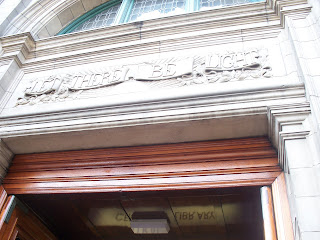.JPG)
After our visit to the National Library of Scotland, we received a tour of a Carnegie Public Library, in Edinburgh. The Central Public Library works in conjunction with the National Archives of Scotland to provide resources for family research. The Central Library acquired an annex in 1989 for archive purposes and duplicate copies of some materials, even though two thirds of the collection is online.
Along with family research, patrons can visit this library to utilize the general collection, the music library, the children's library, and the art library which are separate yet connected spaces in the library. The reference or general collection is an amazing space because of the dome overhead, and the gilded details on the original features. Patrons must apply for and obtain a "library passport" to access the reference library.
The Art library used to house most of its materials in the stacks until it got its own space in the 1930's. The Art library contains materials on paintings, architecture, graphic art and art history. Our tour of the facilities included a description of how the original French architecture was uncovered in the most recent renovations and how all the space is being occupied at the moment.
It was nice to learn about the architecture of the building, and how it works with the librarians and the patrons toward advancing the grander purpose of the library. There is an inscription on the entrance to the reference library that reads, "Tecvm Habita - 1616" which loosely translates as "be comfortable with who you are". This is yet another example of how the space can positively impact the people who are are using it.
The last second half of our time at the Central Library included an amazing question and answer session with some of the librarians on staff and a light snack. One librarian, Colm, specialized in Reader Development, his current project is helping at risk students develop a joy of reading. Colm used his personal experience to show how fulfilling his job could be, and every potential public librarian in our group complimented him and asked him as many questions as she or he could think of. Colm talked about meeting readers were they are at instead of imposing standards on the individual, and helping young readers build confidence in their reading skills.
The last second half of our time at the Central Library included an amazing question and answer session with some of the librarians on staff and a light snack. One librarian, Colm, specialized in Reader Development, his current project is helping at risk students develop a joy of reading. Colm used his personal experience to show how fulfilling his job could be, and every potential public librarian in our group complimented him and asked him as many questions as she or he could think of. Colm talked about meeting readers were they are at instead of imposing standards on the individual, and helping young readers build confidence in their reading skills.
Along with hiring librarians who reach out to under served populations, the Central Library also reaches out to local authors and publishers to collaborate on various literacy initiatives. Some campaigns that the librarians use to appeal to a new generation of patrons include, "You've Got to Read This", "Books That Changed My Life", and a "Make Noise in the Library Workshop". The Central Library is almost 100 years old, but it keeps itself relevant by improving wi-fi connections and showing concern for groups that are often marginalized.
Outside of at risk youth, the librarians talked about initiatives that would improve access for people with disabilities, especially people who have to use wheelchairs. Throughout our class and our amazing library tours, I have wondered if antiquated buildings and institutions ever feel the need to adapt to their patrons. My answer was leaning towards no until this visit. There has to be a balance between respecting the space constraints and historic infrastructure and allowing all individuals to feel autonomous and welcome in the space. This library has shown me that there are many ways to accomplish this task.


No comments:
Post a Comment